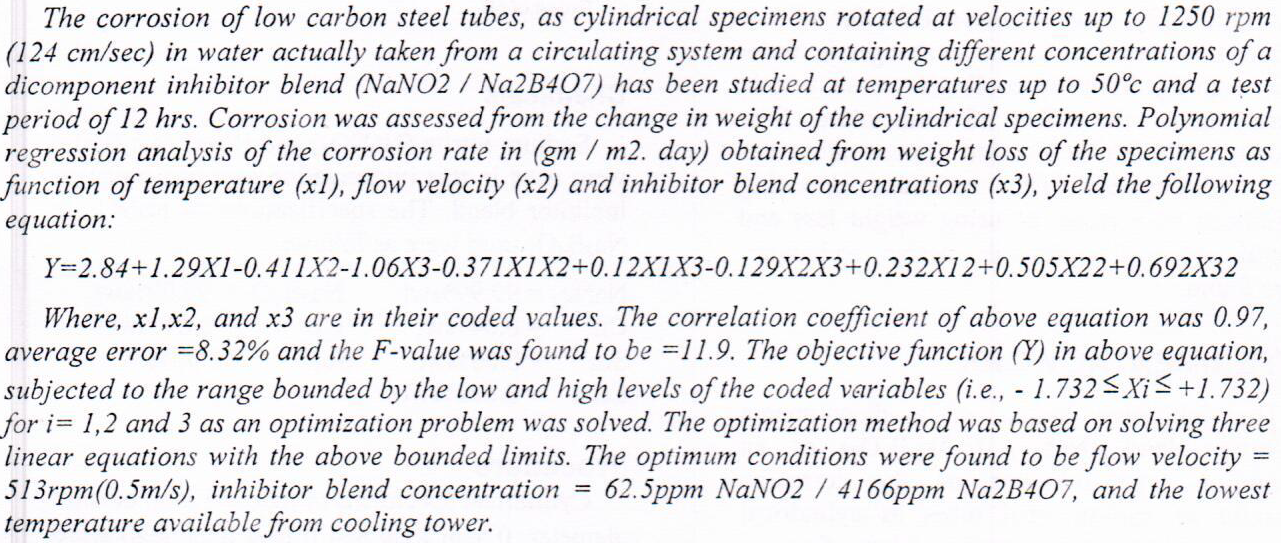
This paper describes the use of microcomputer as a laboratory instrument system. The system is focused on three weather variables measurement, are temperature, wind speed, and wind direction. This instrument is a type of data acquisition system; in this paper we deal with the design and implementation of data acquisition system based on personal computer (Pentium) using Industry Standard Architecture (ISA)bus. The design of this system involves mainly a hardware implementation, and the software programs that are used for testing, measuring and control. The system can be used to display the required information that can be transferred and processed from the external field to the system. A visual basic language with Microsoft foundation cl
... Show More (2)
(2)
The combustion and pyrolysis processes of sewage sludge were studied in the current report. Two kinds of sewage sludge(SS) were used, SS the sewage sludge was not treated, while SS-U90KHz the ultrasonic bath pre-treated sewage sludge with a frequency of 90KHz was not treated. Wastewater treatment plants are the origins of waste sludge. Analyses were performed roughly and finally. Thermogravimetric research analyzed the thermal behaviour of the analysed sewage bucket (TGA). The samples were heated at a constant rate of 25 to 800 Celsius by air (combustion) and nitrogen flow (pyrolysis). For sludges which have been investigated. In the TG/DTG curves, comparable thermal profiles were available. All of the TG/curves DTG’s were divided into th
... Show MoreThe organizational culture is an effective control mechanism that dictates the behavior of employees and according to their intellectual and social orientations, so it is considered a more powerful way to control employee orientations and determine their management according to organizational rules and regulations, as it was one of the most important factors determining the performance of organizations, while organizational performance is a measure of what the organization has achieved from the objectives of the scheme To ensure that it faces various changes and remains within the global competition, and to reach that it was necessary to identify the most prominent and most important research problems in knowing the extent of com
... Show More (1)
(1)
The fall angle of sun rays on the surface of a photovoltaic PV panel and its temperature is negatively affecting the panel electrical energy produced and efficiency. The fall angle problem was commonly solved by using a dual-axis solar tracker that continually maintains the panel orthogonally positioning to the sun rays all day long. This leads to maximum absorption for solar radiation necessary to produce maximum amount of energy and maintain high level of electrical efficiency. To solve the PV panel temperature problem, a Water-Flow Double Glazing WFDG technique has been introduced as a new cooling tool to reduce the panel temperature. In this paper, an integration design of the water glazing system with a dual-axis tracker has been ac
... Show More (4)
(4)
This paper demonstrates an experimental and numerical study on the behavior of reinforced concrete (RC) columns with longitudinal steel embedded tubes positioned at the center of the column cross-section. A total of 12 pin-ended square sectional columns of 150 × 150 mm having a total height of 1400 mm were investigated. The considered variables were the steel tube diameters of 29, 58, and 76 mm and the load eccentricity (0, 50, and 150) mm. Accordingly, these columns were divided into three groups (four columns in each group) depending on the load eccentricity (e) to column depth (h) ratio (e/h = 0, 1/3, and 1). For each group, one column was solid (reference), and the other three columns contained steel tubes with hollow rat
... Show More (17)
(17)
Mature oil reservoirs surrounded with strong edge and bottom water drive aquifers experience pressure depletion and water coning/cresting. This laboratory research investigated the effects of bottom water drive and gas breakthrough on immiscible CO2-Assisted Gravity Drainage (CO2-AGD), focusing on substantial bottom water drive. The CO2-AGD method vertically separates the injected CO2 to formulate a gas cap and Oil. Visual experimental evaluation of CO2-AGD process performance was performed using a Hele-Shaw model. Water-wet sand was used for the experiments. The gas used for injection was pure CO2, and the “oleic” phase was n-decane with a negative spreading coefficient. The aqueous phase was deionized water. To evaluate the feasibilit
... Show More (10)
(10)
 (10)
(10)
 (1)
(1)
 (1)
(1)
New microphotometer was constructed in our Laboratory Which deals with the determination of Molybdenum (VI) through its Catalysis effect on Hydrogen peroxide and potasum iodide Reaction in acid medium H2SO4 0.01 mM. Linearity of 97.3% for the range 5- 100 ppm. The repeatability of result was better than 0.8 % 0.5 ppm was obtanined as L.U. (The method applied for the determination of Molybdenum (VI) in medicinal Sample (centrum). The determination was compared well with the developed method the conventional method.
 (2)
(2)
This paper is concerned with finding solutions to free-boundary inverse coefficient problems. Mathematically, we handle a one-dimensional non-homogeneous heat equation subject to initial and boundary conditions as well as non-localized integral observations of zeroth and first-order heat momentum. The direct problem is solved for the temperature distribution and the non-localized integral measurements using the Crank–Nicolson finite difference method. The inverse problem is solved by simultaneously finding the temperature distribution, the time-dependent free-boundary function indicating the location of the moving interface, and the time-wise thermal diffusivity or advection velocities. We reformulate the inverse problem as a non-
... Show More (1)
(1)
 (1)
(1)
